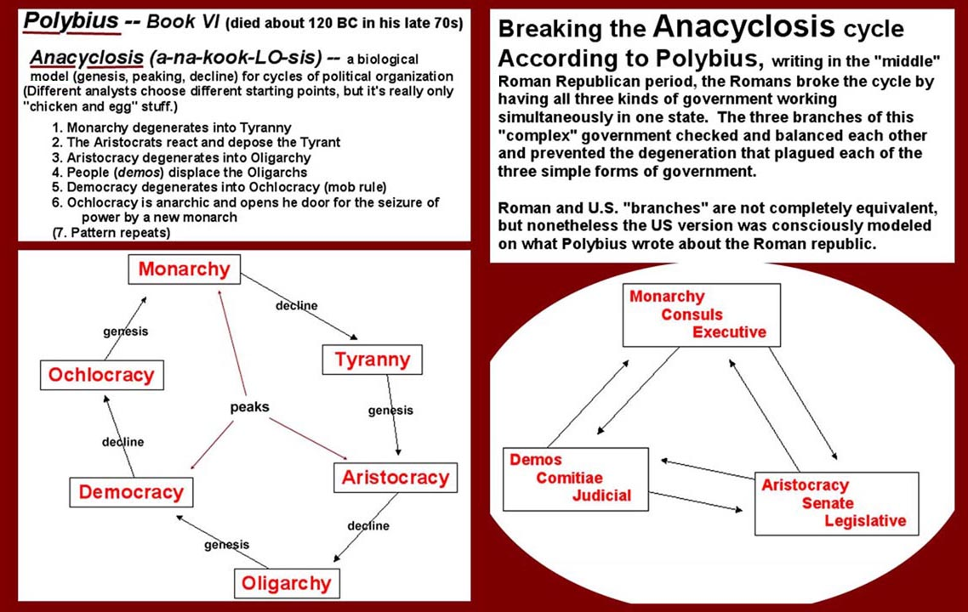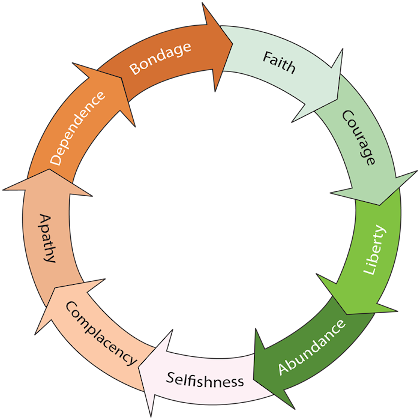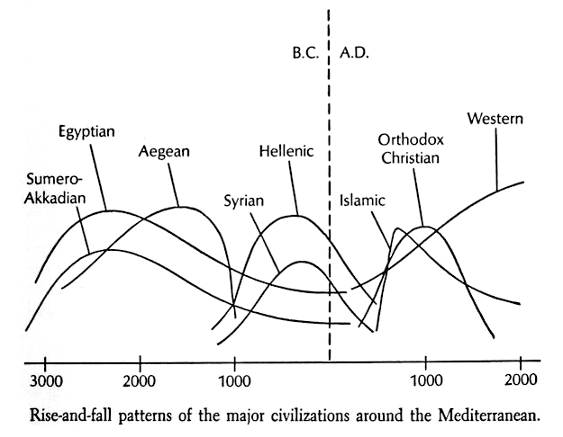Back • Return Home

The Rise and Fall of Societies
There is a lot of information here, some of which I disagree with. It is good to carefully consider different points of view though. These links are shared simply for reference. They are not intented to fill you with worry or fear. There is little point in focusing on them unless you are using them to come up with solutions.
Specific Studies & Programs Related To Current Issues
• SRI International - Changing Images of Man
• The Brundtland Commission - Our Common Future
• National Research Council - Global Environmental Change
• UN - Agenda 21
• UN - Implementation of Agenda 21
• UN - The 2030 Agenda For Sustainable Development
• The Global 2000 Report [Summary]
• FAO - The State of World's Forests 2012
• FAO - The State of World Fisheries and Aquaculture 2014
• WWF - Living Planet Report 2014
• WWF - Living Planet Report 2020
• The World Inequality Report 2022
• The Global Assessment Report on Disaster Risk Reduction 2022
• UNEP - Global Chemicals Outlook
• NBIC - Converging Technologies for Improving Human Performance
• DCDC - Global Strategic Trends Programme (2007-2036) [This is an archive. The same website has a ton of related material.]
• DCDC - Human Augmentation
• Foresight - Future of Food and Farming
• Foresight - International Dimensions of Climate Change
• WEF - The Global Risks Report 2016
• WEF - The Digital Transformation of Industries
• WEF - The Digital Transformation Powering The Great Reset
• OECD - Infrastructure to 2030
• 2030 Water Resources Group - Charting Our Water Future
• The Foreign Policy Center - Tackling The World Water Crisis
• WEC - Deciding the Future: Energy Policy Scenarios to 2050
• Christina Sterbenz and Erin Brodwin - 15 ways the world will be terrifying in 2050
• Christina Sterbenz, Corey Adwar, and Erin Fuchs - 15 ways the world will be awesome in 2050
...This is just a small sampling of resources like this on the Internet.
Statistical Datasets & Real-Time Views
• earth [Special thanks to geouniversal for the link!]
• worldOmeters
• Earth Space Weather
• CIA World Factbook
• EarthStat
• The Millennium Ecosystem Assessment
• The Millennium Project - 15 Global Challenges
• 2052 - A Global Forecast for the Next Forty Years
General Historical Trends & Current Outlooks
• DieOff - Population Collapse [Related to the concept of "peak oil"; e.g.: the work of M. King Hubbert, James Howard Kunstler, et al.]
• Ratical - Collapsologie Immersion
• Michael Dowd - Post-Doom
• Richard Heinberg - Deadly Optimism, Useful Pessimism [Special thanks to iwillneverbehappy for the link!]
• Eric Lee - Existential Concerns
• Deep Adaptation opens up a necessary conversation about the breakdown of civilisation (from OpenDemocracy)
• Reddit - r/CollapseSupport
• Wikipedia - Collapsology
Highlights of Specific Works
• Ancient Models (Hindu, Buddhist, Greek, etc.)
Photo Credit: Star World News
Ancient peoples the world over have separated the entirety of human history into vast units of time, such as the Yugas and the Ages of Man. Each of these is usually associated with some predominant state of consciousness, like the life cycle of a living organism. Everything seems to follow cyclical patterns to some extent, from very short timescales to very long ones (e.g.: The Kondratieff Wave).
This is reflected within our institutions. For example, Aristotle (384-322 BC) attempted to map out the different forms of government and how they become corrupted [click diagram for a larger image]:
Photo Credit: Mathieu Gauthier-Pilote
A historian named Polybius (200-118 BC) arranged this into a cyclical pattern referred to as "Anacyclosis":
Photo Credit: The Freemium Fellow
Some of the politicians of ancient Rome attempted to find a means of circumventing the destructive aspects of that cycle, and that system of government partly inspired the structure of The United States. To quote Thomas K. Wukitsch, a teacher of ancient Mediterranean history and archeology:
Polybius went on to write his history of Roman conquests up to his time. His history included an explanation for his Greek audience of why the stability of Rome's tripartite Republican government made Rome invincible. He might have thought otherwise one hundred years later then the real conquests began sans republic.
Polybius said that in "simple governments" anacyclosis was an inevitable cycle in which mob democracy led to mob rule followed by monarchy, tyranny, aristocracy, plutocracy, then again to democracy, etc., in a never ending circular progression.
The Roman Republic, according to Polybius, had figured out how to avoid the three bad parts of anacyclosis -- mob rule, tyranny, and oligarchy -- by similtaneously having a monarchichal executive branch (actually a duarchy, two co-equal Consuls), an aristocratic legislature (Senate), and a democratic civil court system (the public Comitiae). The three branches naturally checked and balanced each other. If that sounds familiar, it's because the framers of the US Constitution had multiple copies of Polybius at the Constitutional Convention of 1789, thoughtfully provided by Jefferson who was, at the time, the US ambassador in Paris. Some moderns historians credit Charles-Louis de Secondat, Baron de La Brède et de Montesquieu (usually simply "Montesquieu"), with being the originator of the idea of thre branches of government and "checks and balances". In fact, Montesquieu credits the idea to Polybius. Jefferson knew this and sent to the Constitutional Convention copies of the theorizing of both Polybius and Montesquieu.
Later, the American "Founding Fathers" also emulated the Roman "Twelve Tables" when they pursued and adopted the American Bill of Rights -- there were originally to be twelve amendments in the Bill of Rights but only ten were agreed upon. An eleventh of the proposed twelve ammendments later became the 27th Amendment. It dealt with congressional pay raises. The twelfth, which would have mandated representation "by the numbers" rather than proportional representation, never passed.
Here are a couple of his nice summary diagrams:

• Alexander Tytler (1747-1813)

Photo Credit: S.W.A.G. Blog
The Tytler Cycle is an oscillation that civilizations are said to follow every ~200 years.
• Pitirim Sorokin (1889-1968); Arnold J. Toynbee (1889-1975)
Diagram from the book The Turning Point by Fritjof Capra
To quote a section of the above book [on pg. 31-32]:
From our broad perspective of cultural evolution, the current paradigm shift is part of a larger process, a strikingly regular fluctuation of value systems that can be traced throughout Western civilization and most other cultures. These fluctuating changes of values and their effects on all aspects of society, at least in the West, have been mapped out by the sociologist Pitirim Sorokin in a monumental four-volume work written between 1937 and 1941. Sorokin's grand scheme for the synthesis of Western history is based on the cyclical waxing and waning of three basic value systems that underlie all manifestations of a culture.
Sorokin calls these three value systems the sensate, the ideational, and the idealistic. The sensate value system holds that matter alone is the ultimate reality, and that spiritual phenomena are but a manifestation of matter. It professes that all ethical values are relative and that sensory perception is the only source of knowledge and truth. The ideational value system is profoundly different. It holds that true reality lies beyond the material world, in the spiritual realm, and that knowledge can be obtained through inner experience. It subscribes to absolute ethical values and superhuman standards of justice, truth, and beauty. Western representations of the ideational concept of spiritual reality include Platonic ideas, the soul, and Judeo-Christian images of God, but Sorokin points out that similar ideas are expressed in the East, in different form, in Hindu, Buddhist, and Taoist cultures.
Sorokin contends that the cyclical rhythms of interplay between sensate and ideational expressions of human culture also produce an intermediate, synthesizing stage - the idealistic - which represents their harmonious blending. According to idealistic beliefs, true reality has both sensory and supersensory aspects which coexist within an all-embracing unity. Idealistic cultural periods thus tend to attain the highest and noblest expressions of both ideational and sensate styles, producing balance, integration, and esthetic fulfillment in art, philosophy, science, and technology. Examples of such idealistic periods are the Greek flowering of the fifth and fourth centuries, B.C., and the European Renaissance.
• John Glubb (1897-1986)
To quote a section out of his essay, The Fate of Empires:
As numerous points of interest have arisen in the course of this essay, I close with a brief summary, to refresh the reader’s mind.
(a) We do not learn from history because our studies are brief and prejudiced.
(b) In a surprising manner, 250 years emerges as the average length of national greatness.
(c) This average has not varied for 3,000 years. Does it represent ten generations?
(d) The stages of the rise and fall of great nations seem to be:
- The Age of Pioneers (outburst)
- The Age of Conquests
- The Age of Commerce
- The Age of Affluence
- The Age of Intellect
- The Age of Decadence
(e) Decadence is marked by:
- Defensiveness
- Pessimism
- Materialism
- Frivolity
- An influx of foreigners
- The Welfare State
- A weakening of religion
(f) Decadence is due to:
- Too long a period of wealth and power
- Selfishness
- Love of money
- The loss of a sense of duty
(g) The life histories of great states are amazingly similar, and are due to internal factors.
(h) Their falls are diverse, because they are largely the result of external causes.
(i) History should be taught as the history of the human race, though of course with emphasis on the history of the student’s own country.
• Joseph A. Tainter (born 1949)
To quote a synopsis of his paper, Problem Solving - Complexity, History, Sustainability:
Sustainability or collapse follow from the success or failure of problem-solving institutions. The factors that lead to long-term success or failure in problem solving have received little attention, so that this fundamental activity is poorly understood. The capacity of institutions to solve problems changes over time, suggesting that a science of problem solving, and thus a science of sustainability, must be historical. Complexity is a primary problem-solving strategy, which is often successful in the short-term, but cumulatively may become detrimental to sustainability. Historical case studies illustrate different outcomes to long-term development of complexity in problem solving. These cases clarify future options for contemporary societies: collapse, simplification, or increasing complexity based on increasing energy subsidies.
Dr. Tainter has also given lectures on archaeological approaches to sustainability and the collapse of complex societies.
• William Strauss (1947-2007); Neil Howe (born 1951)
To quote a summary of their "Generational Theory":
An average life is 80 years, and consists of four periods of ~20–22 years:
Childhood → Young adult → Midlife → Elderhood
A generation is an aggregate of people born every ~20–22 years:
Baby Boomers → Gen X → Millennials → Homelanders
Each generation experiences "four turnings" every ~80–90 years:
High → Awakening → Unraveling → Crisis
A generation is considered "dominant" or "recessive" according to the turning experienced as young adults. But as a youth generation comes of age and defines its collective persona, an opposing generational archetype is in its midlife peak of power.
Dominant: independent behavior + attitudes in defining an era
Recessive: dependent role in defining an era
Dominant Generations
- Prophet (Idealist): Awakening as young adults. Awakening, defined: Institutions are attacked in the name of personal and spiritual autonomy
- Hero (Civic): Crisis as young adults. Crisis, defined: Institutional life is destroyed and rebuilt in response to a perceived threat to the nation's survival
Recessive Generations
- Nomad (Reactive): Unraveling as young adults. Unraveling, defined: Institutions are weak and distrusted, individualism is strong and flourishing
- Artist (Adaptive): High [when they become] young adults. High, defined: Institutions are strong and individualism is weak






